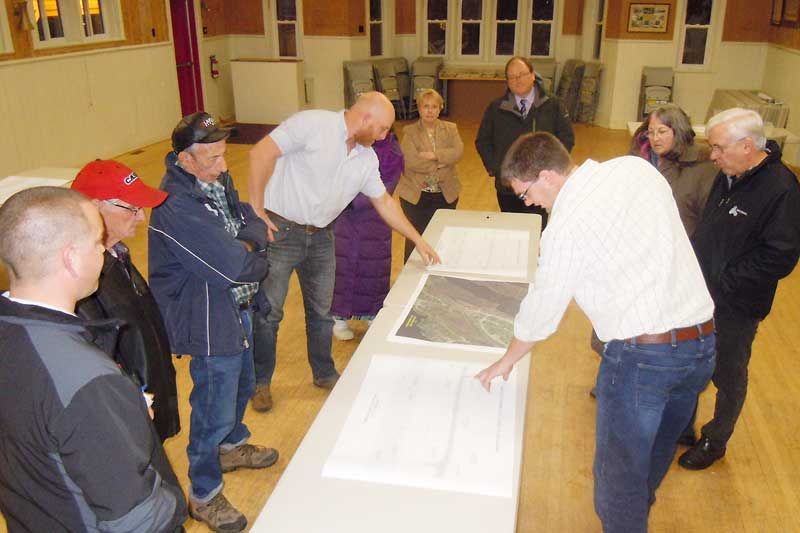Nov 27, 2014
Central Frontenac Public Works Coordinator Kyle Labbett, and Kevin Hawley of Greer Galloway Engineering in Kingston, led a public meeting at Oso hall in Sharbot Lake on November 20.
The meeting was to discuss three options developed by Greer Galloway for the replacement of the bridge on Road 38 that crosses the old CP rail tracks just south of Canon Road. The bridge, which is one of the biggest of the 33 bridge structures in the township, was constructed in 1960 and has been deemed “in immediate need of repair in the next one to five years” following an inspection done by D.M. Wills Associates.
A small group of local residents attended the meeting where Labbett and Hawley explained the plans for the three different options.
The first option is to remove the existing bridge structure, lower the existing grade profile of the roadway and raise the trail by two metres to create a level crossing. In the report done by Greer Galloway, the benefits of this option are that the overall roadway sight lines would be improved and future bridge inspections and repairs would no longer be needed, which would save the township a lot of money in the long term. The disadvantages are the safety concerns that a level crossing poses to trail users, pedestrians and drivers since trail users would have to cross Road 38. Proper signage and /or other traffic mitigation techniques would be required as well as consultation with the trail authority.
Option 2 is to remove the existing bridge and replace it with a pre-cast box culvert. This option would involve lowering the existing roadway by one metre and would be significantly safer than Option 1 as it would keep trail and road traffic completely separate by allowing traffic to continue along Road 38 with no interference from trail users. In addition the sight lines along the roadway would also be improved considerably. The disadvantages are the ongoing costs resulting from regular inspections and maintenance to the box culvert and its inevitable replacement when it surpasses its expected 80-year life span.
The estimated costs of both Options 1 & 2 are approximately $600,000 each, and Hawley said that a large part of the expense in both cases results from the fact that while construction is underway, traffic would have to be diverted. Regarding Options 1 and 2 there is a grant that the township has applied for, which would cover 90% of the costs of construction; however, the grant is not available for option 3, which is to repair the existing bridge at a cost of approximately $300,000 -$400,000.
A repair would involve regular bi-annual inspections, future repairs as well as an inevitable complete bridge replacement once the repaired bridge is eventually deemed no longer safe.
While the expense of traffic diversion for a bridge repair costs less since one lane of the road would always be left open during construction, the long-term costs of a repair that will not last was questioned. Hawley said that option 3 is the least expensive in the short term, but he called it “a band aid solution” with long term costs. Labbett agreed, stating, “Everyone seems to be in agreement that repairing the existing bridge (Option 3) is not smart financially in the long run so we're basically looking at Option 1 or 2 more seriously right now."
Most of the residents who attended the meeting seemed to support Option 2, the box culvert option and Sharbot Lake residents Bill and Barb Wilson stressed the safety concerns that Option 1 would pose to motorists, trail users and pedestrians alike. “Safety concerns are paramount and I think that the box culvert seems the safest option,” Bill Wilson said.
The majority of the residents I spoke to at the meeting were in agreement. Staff at the township will find out in February 2015 whether their grant is successful and will likely make a final decision when the new council resumes later this year, and no doubt well before the required five-year deadline.
If the grant is successful and whether council opts for either the level crossing or the box culvert solution, there is good chance construction could begin in the summer of 2015.
More Stories
- Latest CUPW Job Action Stops Postal Delivery Of The Frontenac News Forcing Alternate Plans
- Opponents of Barbers Lake Gravel Pit Pack Ag Hall in McDonalds Corners
- Bobsleigh Olympian Jay Dearborn At Mikes Pizza In Sydenham
- The Loins Club Of and O'Lakes Roar
- North Frontenac Back Roads Studio Tour - September 27 and 28
- Sunday Market Vendors Give Back
- George Street Work As Town Hall Renovation Nears Completion
- One Way Street Plan Hits A Dead End - Central Frontenac Council, September 9
- Global Gardening
- No Winner Yet in Catch The Ace But Fundraising Target Met

